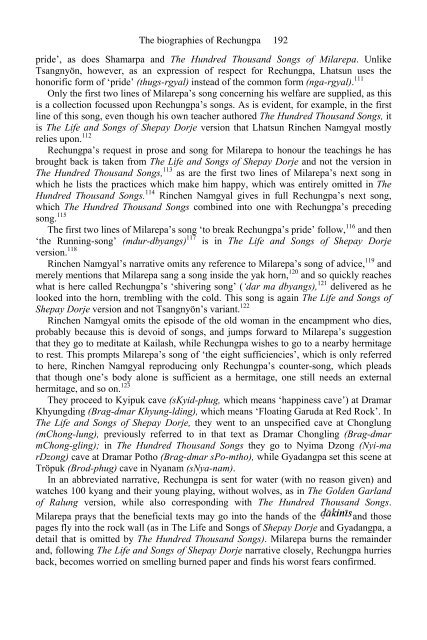The Biographies of Rechungpa: The Evolution of a Tibetan ...
The Biographies of Rechungpa: The Evolution of a Tibetan ...
The Biographies of Rechungpa: The Evolution of a Tibetan ...
You also want an ePaper? Increase the reach of your titles
YUMPU automatically turns print PDFs into web optimized ePapers that Google loves.
<strong>The</strong> biographies <strong>of</strong> <strong>Rechungpa</strong> 192<br />
pride’, as does Shamarpa and <strong>The</strong> Hundred Thousand Songs <strong>of</strong> Milarepa. Unlike<br />
Tsangnyön, however, as an expression <strong>of</strong> respect for <strong>Rechungpa</strong>, Lhatsun uses the<br />
honorific form <strong>of</strong> ‘pride’ (thugs-rgyal) instead <strong>of</strong> the common form (nga-rgyal). 111<br />
Only the first two lines <strong>of</strong> Milarepa’s song concerning his welfare are supplied, as this<br />
is a collection focussed upon <strong>Rechungpa</strong>’s songs. As is evident, for example, in the first<br />
line <strong>of</strong> this song, even though his own teacher authored <strong>The</strong> Hundred Thousand Songs, it<br />
is <strong>The</strong> Life and Songs <strong>of</strong> Shepay Dorje version that Lhatsun Rinchen Namgyal mostly<br />
relies upon. 112<br />
<strong>Rechungpa</strong>’s request in prose and song for Milarepa to honour the teachings he has<br />
brought back is taken from <strong>The</strong> Life and Songs <strong>of</strong> Shepay Dorje and not the version in<br />
<strong>The</strong> Hundred Thousand Songs, 113 as are the first two lines <strong>of</strong> Milarepa’s next song in<br />
which he lists the practices which make him happy, which was entirely omitted in <strong>The</strong><br />
Hundred Thousand Songs. 114 Rinchen Namgyal gives in full <strong>Rechungpa</strong>’s next song,<br />
which <strong>The</strong> Hundred Thousand Songs combined into one with <strong>Rechungpa</strong>’s preceding<br />
song. 115<br />
<strong>The</strong> first two lines <strong>of</strong> Milarepa’s song ‘to break <strong>Rechungpa</strong>’s pride’ follow, 116 and then<br />
‘the Running-song’ (mdur-dbyangs) 117 is in <strong>The</strong> Life and Songs <strong>of</strong> Shepay Dorje<br />
version. 118<br />
Rinchen Namgyal’s narrative omits any reference to Milarepa’s song <strong>of</strong> advice, 119 and<br />
merely mentions that Milarepa sang a song inside the yak horn, 120 and so quickly reaches<br />
what is here called <strong>Rechungpa</strong>’s ‘shivering song’ (‘dar ma dbyangs), 121 delivered as he<br />
looked into the horn, trembling with the cold. This song is again <strong>The</strong> Life and Songs <strong>of</strong><br />
Shepay Dorje version and not Tsangnyön’s variant. 122<br />
Rinchen Namgyal omits the episode <strong>of</strong> the old woman in the encampment who dies,<br />
probably because this is devoid <strong>of</strong> songs, and jumps forward to Milarepa’s suggestion<br />
that they go to meditate at Kailash, while <strong>Rechungpa</strong> wishes to go to a nearby hermitage<br />
to rest. This prompts Milarepa’s song <strong>of</strong> ‘the eight sufficiencies’, which is only referred<br />
to here, Rinchen Namgyal reproducing only <strong>Rechungpa</strong>’s counter-song, which pleads<br />
that though one’s body alone is sufficient as a hermitage, one still needs an external<br />
hermitage, and so on. 123<br />
<strong>The</strong>y proceed to Kyipuk cave (sKyid-phug, which means ‘happiness cave’) at Dramar<br />
Khyungding (Brag-dmar Khyung-lding), which means ‘Floating Garuda at Red Rock’. In<br />
<strong>The</strong> Life and Songs <strong>of</strong> Shepay Dorje, they went to an unspecified cave at Chonglung<br />
(mChong-lung), previously referred to in that text as Dramar Chongling (Brag-dmar<br />
mChong-gling); in <strong>The</strong> Hundred Thousand Songs they go to Nyima Dzong (Nyi-ma<br />
rDzong) cave at Dramar Potho (Brag-dmar sPo-mtho), while Gyadangpa set this scene at<br />
Tröpuk (Brod-phug) cave in Nyanam (sNya-nam).<br />
In an abbreviated narrative, <strong>Rechungpa</strong> is sent for water (with no reason given) and<br />
watches 100 kyang and their young playing, without wolves, as in <strong>The</strong> Golden Garland<br />
<strong>of</strong> Ralung version, while also corresponding with <strong>The</strong> Hundred Thousand Songs.<br />
Milarepa prays that the beneficial texts may go into the hands <strong>of</strong> the and those<br />
pages fly into the rock wall (as in <strong>The</strong> Life and Songs <strong>of</strong> Shepay Dorje and Gyadangpa, a<br />
detail that is omitted by <strong>The</strong> Hundred Thousand Songs). Milarepa burns the remainder<br />
and, following <strong>The</strong> Life and Songs <strong>of</strong> Shepay Dorje narrative closely, <strong>Rechungpa</strong> hurries<br />
back, becomes worried on smelling burned paper and finds his worst fears confirmed.











